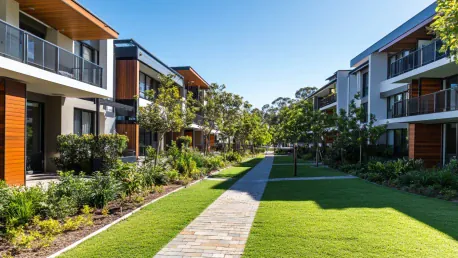The Green Building Council of Australia (GBCA) has recently introduced the Green Star rating system for apartments. They aim to address urgent issues such as housing affordability, denser urban living, and climate change. According to GBCA CEO Davina Rooney, this innovative initiative supports developers in creating cost-effective and sustainable housing solutions that benefit both the environment and residents financially. The new rating system promises to balance the initial costs with long-term financial and environmental advantages, reflecting a growing commitment to sustainability in the Australian housing market.
Affordable Sustainability
Recent surveys have shown that Australian buyers prioritize affordability in sustainable apartments, although many lack clarity regarding eligibility criteria and available incentives. Despite these challenges, sustainability is becoming an increasingly significant factor in purchasing decisions, with an impressive 81% of buyers considering green features either critical or important. This trend is not only shaping consumer behavior but also influencing financial institutions. There is a growing trend among lenders to offer green loans, yet a gap remains in financial products specifically geared towards sustainable apartments. Gateway Bank has led the way by accepting the Green Star Apartments certification as part of its Green Home Loan criteria. It is anticipated that other lenders will soon follow suit, recognizing the value and demand for sustainable living.
The Green Star rating system suggests that constructing sustainable apartments entails a minor upfront cost increase of about 1.3% compared to traditional buildings. However, this modest initial investment is predicted to yield substantial long-term financial benefits, including reduced loan repayments, lower energy costs, and increased property values. For instance, modeling indicates that a $900,000 apartment in Sydney could generate nearly $111,000 in total benefits over a 30-year period. The financial advantages serve to make a compelling case for developers and buyers alike to embrace sustainable housing solutions, emphasizing the economic feasibility of green buildings alongside their environmental benefits.
Environmental and Social Impact
Green Star apartments are set to make significant contributions to environmental sustainability by reducing carbon emissions, alleviating pressures on the energy grid, enhancing water efficiency, and improving home resilience against extreme weather conditions. These widespread benefits are not just theoretical but are being actively demonstrated through collaborations between GBCA and several industry leaders. Prominent developers such as Cbus Property and Lendlease are partnering with GBCA to pilot this initiative in ongoing projects. These collaborations aim to showcase the practical advantages of sustainable design, including lower operating costs and increased resident comfort, thereby reinforcing the value proposition of green apartments.
Cbus Property’s CEO, Adrian Pozzo, emphasizes that these developments offer substantial long-term savings and improved living standards for residents. Their project at 185 Wharf Street, designed by Rothelowman and scheduled for completion in 2027, is poised to set new benchmarks in sustainable apartment living. Such pioneering efforts underscore the broader industry trend towards eco-friendly construction practices and highlight the tangible benefits of integrating sustainability into real estate development. By adopting the Green Star rating system, developers not only contribute to environmental conservation but also create healthier, more livable, and financially viable housing options.
Future of Green Star Apartments
The Green Building Council of Australia (GBCA) has recently rolled out the Green Star rating system specifically for apartments, targeting pressing issues such as housing affordability, urban density, and climate change. According to Davina Rooney, CEO of GBCA, this groundbreaking initiative aids developers in creating affordable and sustainable housing that positively impacts both the environment and the residents’ wallets. This new rating system seeks to balance the upfront costs with long-term financial and ecological benefits, mirroring an increasing dedication to sustainability in Australia’s housing sector. Rooney emphasizes that the approach is a strategic response to the current and future challenges faced by the housing market. Developers are encouraged to embrace this system to not only fulfill a growing market demand but also to contribute to a healthier planet and more affordable living spaces for Australians. Through this initiative, GBCA aims to foster a housing market where sustainability and affordability go hand in hand.









